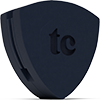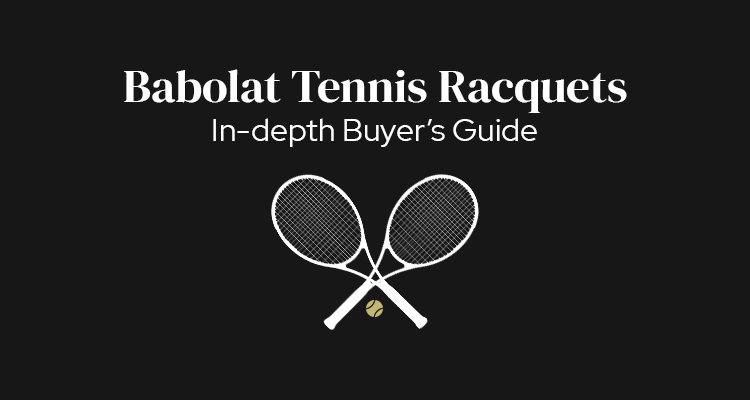Check out my custom vibration dampener
Babolat Tennis Racquets Explained
In-depth Buyer’s Guide
We hope you love this article. Just so you know, TennisCompanion may collect a small share of sales from the links on this page to help keep this site running. Learn more.
With a long and storied history in tennis, Babolat has emerged as one of the preeminent racquet manufacturers, developing a highly accessible line of products for players of all ages and levels.
Tune into any ATP or WTA tournament or show up at your local public courts, and you’ll likely find plenty of players using their racquets, making them an enticing option if you’re in the market.
However, if you’ve started researching Babolat, you’ve likely found that there are way more options to consider than you might have anticipated, which can quickly become overwhelming.
To help simplify and narrow down your options, I’ll explain each of Babolat’s racquet lines so you can easily compare them and provide tips for choosing a frame that meets your needs.
I’ll also answer questions I regularly get from players about Babolat racquets, provide recommendations by skill level, and share my picks for their best frames so you can decide if they’re a good fit or whether you should consider exploring other options, such as Wilson, Head, or Yonex.
| Racquet Line | Latest Release |
| Babolat Pure Aero Rafa | 2023 |
| Babolat Pure Aero | 2022 |
| Babolat Pure Drive | 2020 |
| Babolat Pure Strike | 2019 |
| Babolat EVO | 2023 |
| Babolat Boost | 2023 |
Please note that the latest release dates are when the racquet actually released, so it may not align with some of the naming conventions you see online.
For example, Babolat released the seventh generation of the Pure Aero on August 25, 2022, but most retailers use the 2023 naming convention since that’s the first full year it was available.
Article Contents
Click below to jump to a section
Tap below to jump to a section
About Babolat
Racquet Lines
How to Choose a Racquet
Best Babolat Racquet
Pros Using Babolat
Men’s vs. Women’s
Quality Control
Demos
Warranties
New to TennisCompanion?
Create a free account and explore my latest videos below
About Babolat
In 1875, Pierre Babolat developed the first natural gut tennis strings, which remained the gold standard for the sport until the 1990s, when polyester tennis strings entered the fray.
To this day, Babolat VS Touch remains a best-in-class offering, but the company now offers far more than strings. In the 1960s, they expanded their product line to include accessories like grips, followed by racquets in 1994 with the Pure Drive lineup.
Since then, Babolat has become one of the most dominant racquet and string manufacturers worldwide with the support of some of the most talented players in the game endorsing their gear, including Rafael Nadal, Karolina Pliskova, Carlos Alcaraz, Garbine Muguruza, and Holger Rune.
Furthermore, Babolat now offers a full range of tennis products, including shoes, bags, and apparel, helping cement its place as one of the leading tennis brands in the market.
Racquet Lines
Babolat offers five different lines of tennis racquets for adults, each designed to deliver a specific set of performance characteristics to give players a wide range of options. They also offer a variety of children’s racquets for kids and juniors.
Within each line, you’ll find several tennis racquets that share the same visual look but offer distinct specifications, such as a larger head size, giving players additional options to find a racquet that most closely aligns with their needs and preferences.
In this section, I’ll discuss each line of tennis racquets and the available variations within each line. At a high level, here’s what you can expect from each line.
| Line | Key Selling Point |
| Pure Drive | Power |
| Pure Aero | Spin |
| Pure Strike | Control |
| EVO | Recreational Play |
| Boost | Entry Level |
Pure Drive
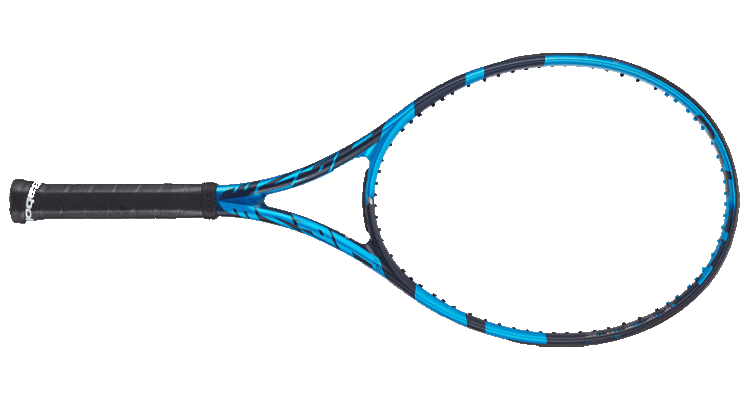
The Pure Drive is the evolution of Babolat’s original frame they designed in 1994. Like previous generations, the racquet emphasizes power as the dominant attribute while delivering plenty of spin that aggressive baseline players crave.
However, its ability to deliver well-rounded all-court performance sets the Pure Drive apart from many other racquets in its class that provide similar power levels.
Babolat offers an extended length option within the Pure Drive line, denoted by ‘Plus,’ for even more power, spin, and reach. Rather than the standard 27-inch (68.6) length for adult racquets, these are 27.5 inches (69.9 cm) long. As a result, shorter players or those looking to maximize these attributes often gravitate toward these frames.
Overall, this line is the most approachable or user-friendly of all Babolat’s performance racquets, with several variations, including larger, more forgiving head sizes and lighter options to appeal to a wide range of players from beginners to advanced.
Pros
- Power
- Topspin
- Larger sweetspot
Cons
- Comfort
- Control
Pure Drive Comparison Table
| Spec | Babolat Pure Drive | Babolat Pure Drive Plus | Babolat Pure Drive Team | Babolat Pure Drive Lite | Babolat Pure Drive 107 | Babolat Pure Drive 110 |
| Head Size | 100 in² / 645.16 cm² | 100 in² / 645.16 cm² | 100 in² / 645.16 cm² | 100 in² / 645.16 cm² | 107 in² / 690.32 cm² | 110 in² / 709.68 cm² |
| Length | 27in / 68.58cm | 27.5in / 69.85cm | 27in / 68.58cm | 27in / 68.58cm | 27.2in / 69.09cm | 27.6in / 70.1cm |
| Strung Weight | 11.2oz / 318g | 11.2oz / 318g | 10.6oz / 301g | 10oz / 283g | 10.6oz / 301g | 9.5oz / 269g |
| Balance | 12.99in / 32.99cm / 4 pts HL | 12.99in / 32.99cm / 6 pts HL | 12.85in / 32.64cm / 5 pts HL | 13.4in / 34.04cm / 1 pts HL | 12.99in / 32.99cm / 5 pts HL | 13.37in / 33.96cm / 3 pts HL |
| Swingweight | 320 | 324 | 313 | 299 | 309 | 298 |
| Stiffness | 71 | 69 | 69 | 69 | 69 | 70 |
| Beam Width | 23mm / 26mm / 23mm | 23mm / 26mm / 23mm | 23mm / 26mm / 23mm | 23mm / 26mm / 23mm | 23mm / 26mm / 23mm | 24mm / 26.5mm / 23.5mm |
| Composition | Graphite | Graphite | Graphite | Graphite | Graphite | Graphite |
| Power Level | Low-Medium | Low-Medium | Low-Medium | Low-Medium | Medium | Medium-High |
| Stroke Style | Medium-Full | Medium-Full | Medium-Full | Medium-Full | Medium | Compact-Medium |
| Swing Speed | Medium-Fast | Medium-Fast | Medium-Fast | Medium-Fast | Medium | Slow-Moderate |
| Grip Type | Babolat Syntec Pro | Babolat Syntec Pro | Babolat Syntec Pro | Babolat Syntec Pro | Babolat Syntec Pro | Babolat Syntec Lite |
| String Pattern | 16 Mains / 19 Crosses | 16 Mains / 19 Crosses | 16 Mains / 19 Crosses | 16 Mains / 19 Crosses | 16 Mains / 19 Crosses | 16 Mains / 19 Crosses |
| String Tension | 50-59 pounds | 50-59 pounds | 50-59 pounds | 50-59 pounds | 50-59 pounds | 50-59 pounds |
Pure Aero
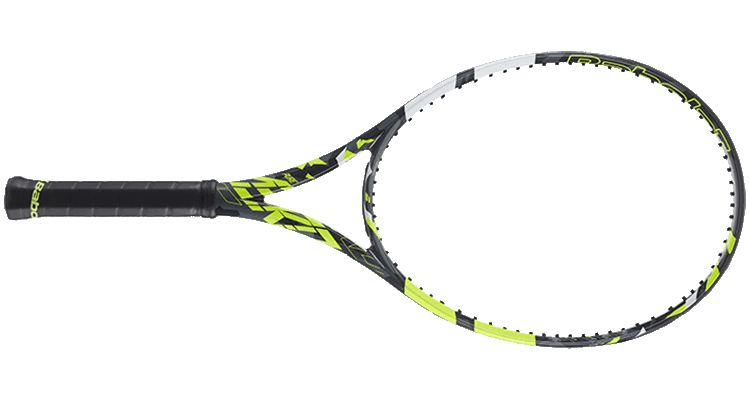
Players familiar with the Pure Aero will recognize the racquet is synonymous with Rafael Nadal, whose success and longevity have helped to make it one of the best-selling racquets.
What’s unique about this racquet is that Babolat crafted the original model to play to Rafa’s strengths, specifically to help him increase racquet head speed with an aerodynamic design that enabled him to maximize topspin.
Although Rafa still uses the original AeroPro Drive, the latest generation retains the essence of the original model with features and design considerations that emphasize spin first and foremost.
However, beyond spin, you’ll find the Pure Aero delivers plenty of power, which pairs nicely. Like the Pure Drive, it’s a well-rounded racquet that provides solid performance hitting various shots from all areas of the court.
It’s worth noting that in this family of racquets, you’ll find the Pure Aero VS, featuring a 98 in² head size vs. the standard 100 in² on the other models. With a bit of extra weight and a thinner beam, Babolat introduced the racquet to appeal to higher-level players that demand even more control.
There’s also an extended-length version, which at 27.5 inches (69.9 cm) is a half inch longer than a standard adult racquet, providing extra reach, power, and spin.
Pure Drive vs. Pure Aero
Although the Pure Drive and Pure Aero share similar attributes, I find the Pure Aero delivers added control and better feel, particularly at net, for a more well-rounded performance. At the same time, the Pure Drive offers notably more power, so a player’s preference will boil down to their priorities.
Pros
- Power
- Topspin
- Control
Cons
- Comfort
- Lack of feel
Pure Aero Comparison Table
| Spec | Babolat Pure Aero VS | Babolat Pure Aero 98 2023 | Babolat Pure Aero Tour | Babolat Pure Aero 2023 | Babolat Pure Aero Plus 2023 | Babolat Pure Aero Lite 2023 | Babolat Pure Aero Team 2023 |
| Head Size | 98 in / 632.26 cm² | 98 in / 632.26 cm² | 100 in² / 645.16 cm² | 100 in / 645.16 cm² | 100 in / 645.16 cm² | 100 in / 645.16 cm² | 100 in / 645.16 cm² |
| Length | 27in / 68.58cm | 27in / 68.58cm | 27in / 68.58cm | 27in / 68.58cm | 27.5in / 69.85cm | 27in / 68.58cm | 27in / 68.58cm |
| Strung Weight | 11.3oz / 320g | 11.4oz / 323g | 11.8oz / 335g | 11.2oz / 318g | 11.3oz / 320g | 10oz / 283g | 10.6oz / 301g |
| Balance | 12.75in / 32.39cm / 6 pts HL | 12.79in / 32.49cm / 6 pts HL | 12.7in / 32.26cm / 6 pts HL | 12.99in / 32.99cm / 4 pts HL | 12.99in / 32.99cm / 6 pts HL | 13.38in / 33.99cm / 1 pts HL | 12.85in / 32.64cm / 5 pts HL |
| Swingweight | 321 | 327 | 327 | 322 | 334 | 304 | 302 |
| Stiffness | 67 | 65 | 68 | 65 | 65 | 65 | 67 |
| Beam Width | 21mm / 23mm / 22mm | 21mm / 23mm / 22mm | 23mm / 26mm / 23mm | 23mm / 26mm / 23mm | 23mm / 26mm / 23mm | 23mm / 26mm / 23mm | 23mm / 26mm / 23mm |
| Composition | Graphite | Graphite | Graphite | Graphite | Graphite | Graphite | Graphite |
| Power Level | Low-Medium | Low-Medium | Low-Medium | Low-Medium | Low-Medium | Low-Medium | Low-Medium |
| Stroke Style | Medium-Full | Medium-Full | Medium-Full | Medium-Full | Medium-Full | Medium-Full | Medium-Full |
| Swing Speed | Medium-Fast | Medium-Fast | Medium-Fast | Medium-Fast | Medium-Fast | Medium-Fast | Medium-Fast |
| Grip Type | Syntec Pro | Syntec Pro | Babolat Syntec Pro | Babolat Syntec Pro | Babolat Syntec Pro | Babolat Syntec Pro | Babolat Syntec Pro |
| String Pattern | 16 Mains / 20 Crosses | 16 Mains / 20 Crosses | 16 Mains / 19 Crosses | 16 Mains / 19 Crosses | 16 Mains / 19 Crosses | 16 Mains / 19 Crosses | 16 Mains / 19 Crosses |
| String Tension | 50-59 pounds | 50-59 pounds | 50-59 pounds | 50-59 pounds | 50-59 pounds | 50-59 pounds | 50-59 pounds |
Pure Strike
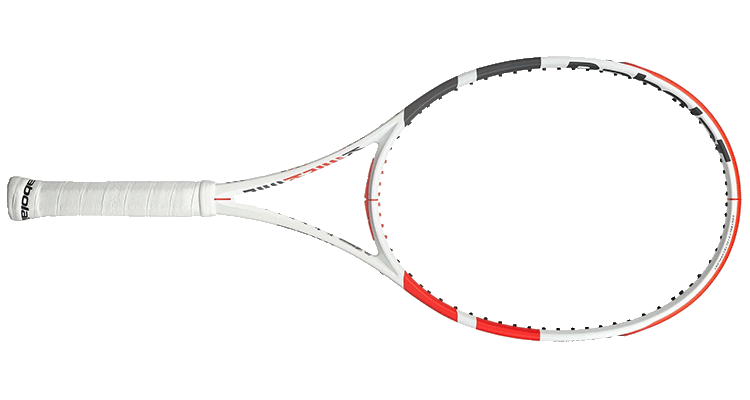
Compared to the Pure Drive and Pure Aero, the Babolat Pure Strike offers players a markedly different option, emphasizing better control and added feel for excellent all-court performance.
That’s not to say the frame is void of power and spin, but Babolat seeks to find more of a balance for those who play with added finesse and find themselves moving forward and playing the net as much as they like battling it out at the baseline.
Within this family of racquets, you’ll also find the standard options feature a slightly smaller 98 in² head size vs. the larger 100 in² you’ll find on most of Babolat’s other racquets. This change, along with a thinner beam, more flexible frame, and some added weight, aims to deliver added control and precision for more advanced players with plenty of experience.
Pros
- Balance of power and control
- Topspin
- Feel
- Stability
Cons
- Comfort
Pure Strike Comparison Table
| Spec | Babolat Pure Strike VS | Babolat Pure Strike 16×19 3rd Gen | Babolat Pure Strike 18×20 3rd Gen | Babolat Pure Strike Tour 3rd Gen | Babolat Pure Strike 100 3rd Gen | Babolat Pure Strike Team 3rd Gen | Babolat Pure Strike 103 |
| Head Size | 97 in / 625.81 cmcm² | 98 in² / 632.26 cm² | 98 in2 / 632.26 cm² | 98 in² / 632.26 cm² | 100 in² / 645.16 cm² | 100 in² / 645.16 cm² | 103 in / 664.51 cm |
| Length | 27in / 68.58cm | 27in / 68.58cm | 27in / 68.58cm | 27in / 68.58cm | 27in / 68.58cm | 27in / 68.58cm | 27in / 68.58cm |
| Strung Weight | 11.7oz / 332g | 11.4oz / 323g | 11.4oz / 323g | 12oz / 340g | 11.1oz / 315g | 10.7oz / 303g | 10.6oz / 301g |
| Balance | 12.59in / 31.98cm / 7 pts HL | 13in / 33.02cm / 4 pts HL | 13in / 33.02cm / 4 pts HL | 12.79in / 32.49cm / 6 pts HL | 12.99in / 32.99cm / 4 pts HL | 13.38in / 33.99cm / 1 pts HL | 13in / 33.02cm / 4 pts HL |
| Swingweight | 322 | 327 | 334 | 333 | 319 | 309 | 303 |
| Stiffness | 63 | 66 | 66 | 65 | 69 | 69 | 65 |
| Beam Width | 21mm / 22mm / 21mm | 21mm / 23mm / 21mm | 21mm / 23mm / 21mm | 21mm / 23mm / 21mm | 21mm / 23mm / 21mm | 21mm / 23mm / 21mm | 21mm / 23mm / 21mm |
| Composition | Graphite | Graphite | Graphite | Graphite | Graphite | Graphite | Graphite |
| Power Level | Low-Medium | Low-Medium | Low | Low-Medium | Low-Medium | Low-Medium | Low-Medium |
| Stroke Style | Medium-Full | Medium-Full | Full | Medium-Full | Medium-Full | Medium-Full | Medium-Full |
| Swing Speed | Medium-Fast | Medium-Fast | Fast | Medium-Fast | Medium-Fast | Medium-Fast | Medium-Fast |
| Grip Type | Leather | Babolat Syntec Team | Babolat Syntec Team | Babolat Syntec Team | Babolat Syntec Team | Babolat Syntec Team | Babolat Syntec Team |
| String Pattern | 16 Mains / 20 Crosses | 16 Mains / 19 Crosses | 18 Mains / 20 Crosses | 16 Mains / 19 Crosses | 16 Mains / 19 Crosses | 16 Mains / 19 Crosses | 16 Mains / 19 Crosses |
| String Tension | 50-59 pounds | 50-59 pounds | 50-59 pounds | 50-59 pounds | 50-59 pounds | 50-59 pounds | 50-59 pounds |
EVO
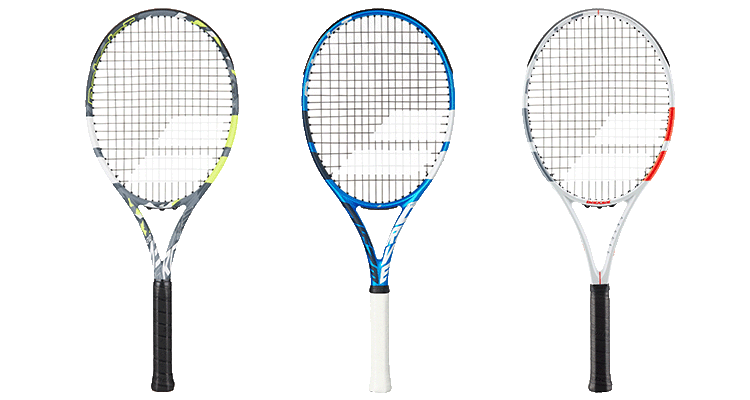
The EVO line of racquets from Babolat is a new range with lower price points designed for two specific audiences.
First, these racquets are excellent entry-level options for adults who enjoy playing tennis for recreation and exercise. However, they’re also well-suited for younger players transitioning to full-sized adult racquets. That’s because their lighter, and thus more maneuverable, and feature slightly larger head sizes than their high-end performance models, providing extra margin for error when swinging to hit the ball.
Where some people get confused is Babolat carries the name of their performance racquets into this line, so you end up with naming conventions like the following:
- Babolat EVO Aero
- Babolat EVO Drive
- Babolat Pure Strike EVO
Although this is a separate line of racquets from the performance lines we’ve discussed in the previous sections, each has similar attributes to the higher-end models. That is Aero for spin, Drive for power, and Pure Strike for control.
From Babolat’s standpoint, this branding play begins to funnel players down a specific path earlier in their tennis journey, so there’s less guesswork for players as they mature. Suppose you’re using the Babolat EVO Aero as a beginner and enjoy the racquet. In that case, it’s logical to transition into their premium Aero line when and if you decide to upgrade your racquet.
As a bonus, all Babolat EVO racquets come pre-strung for added value, but more importantly, they result in fewer decision points for new players. If you buy an unstrung racquet, you still have to select a string and tension to match your racquet, which adds friction to getting started. The EVO lines remove this barrier by preinstalling an economical synthetic gut string within the frame’s recommended tension range.
Overall, the Babolat EVO line of racquets is an excellent entry-level and transitional option for players who demand more from their racquet than what you get with a cheap tennis racquet.
Pros
- Affordable
- Ease of use
- Power
- Spin
Cons
- Stability
- Feel
- Control
- Maneuverable
EVO Comparison Table
| Spec | Babolat EVO Aero | Babolat EVO Aero Lite | Babolat EVO Drive | Babolat EVO Drive Lite | Babolat EVO Drive 115 | Babolat Pure Strike EVO |
| Head Size | 102 in² / 658.06 cm² | 102 in² / 658.06 cm² | 104 in² / 670.97 cm² | 104 in² / 670.97 cm² | 115 in² / 741.93 cm² | 102 in² / 658.06 cm² |
| Length | 27in / 68.58cm | 27in / 68.58cm | 27in / 68.58cm | 27in / 68.58cm | 27.6in / 70.1cm | 27in / 68.58cm |
| Strung Weight | 10.2oz / 289g | 9.7oz / 275g | 10oz / 283g | 9.5oz / 269g | 9oz / 255g | 10.4oz / 295g |
| Balance | 12.99in / 32.99cm / 4 pts HL | 12.99in / 32.99cm / 4 pts HL | 13in / 33.02cm / 4 pts HL | 13in / 33.02cm / 4 pts HL | 13.75in / 34.93cm / 0 pts EB | 13in / 33.02cm / 4 pts HL |
| Swingweight | 301 | 294 | 302 | 298 | 313 | 308 |
| Stiffness | 60 | 60 | 68 | 67 | 67 | 65 |
| Beam Width | 23mm / 26mm / 23mm | 23mm / 26mm / 23mm | 23mm / 26mm / 23mm | 23mm / 26mm / 23mm | 25mm / 28mm / 24mm | 23mm / 25mm / 23mm |
| Composition | Graphite | Graphite | Graphite | Graphite | Graphite | Graphite |
| Power Level | Low-Medium | Low-Medium | Low-Medium | Low-Medium | Medium | Low-Medium |
| Stroke Style | Medium-Full | Medium-Full | Medium-Full | Medium-Full | Medium | Medium-Full |
| Swing Speed | Medium-Fast | Medium-Fast | Medium-Fast | Medium-Fast | Medium | Medium-Fast |
| Grip Type | Babolat Syntec EVO | Babolat Syntec EVO | Babolat Syntec Evo | Babolat Syntec Evo | Babolat Syntec Evo | Babolat Synthetic |
| String Pattern | 16 Mains / 18 Crosses | 16 Mains / 18 Crosses | 16 Mains / 17 Crosses | 16 Mains / 17 Crosses | 16 Mains / 17 Crosses | 16 Mains / 19 Crosses |
| String Tension | 50-55 pounds | 50-55 pounds | 50-55 pounds | 50-55 pounds | 50-55 pounds | 50-55 pounds |
Boost

One step down from Babolat’s EVO racquets is their Boost line, their most economical and accessible offering. Like the EVO line, you’ll also find these racquets carry similar naming conventions to Babolat’s performance racquets, including:
- Babolat Boost Aero
- Babolat Boost Drive
- Babolat Boost Strike
These racquets are similar to the EVO line in that they’re lightweight, maneuverable, pre-strung, and feature larger head sizes for more surface area when swinging to hit the ball. However, their weight is even lighter than the EVO lines, making them the easiest to handle for players just starting.
Despite that, what I love about the Boost line is that Babolat still constructs them with graphite, the dominant material in use across all premium tennis racquets, vs. the cheaper aluminum you’ll find used for the least expensive options from other brands.
The result is a fairly priced entry-level racquet that doesn’t skimp on performance, perfectly suited for beginners.
Pros
- Affordable
- Ease of use
- Power
- Spin
- Maneuverable
Cons
- Stability
- Feel
- Control
Boost Comparison Table
| Spec | Babolat Boost Aero Rafa | Babolat Boost Aero | Babolat Boost Drive 2021 | Babolat Boost S (Strike) | Babolat EVOKE 102 | Babolat EVOKE 105 |
| Head Size | 102 in² / 658.06 cm² | 102 in² / 658.06 cm² | 105 in² / 677.42 cm² | 102 in² / 658.06 cm² | 102 in² / 658.06 cm² | 105 in² / 677.42 cm² |
| Length | 27in / 68.58cm | 27in / 68.58cm | 27in / 68.58cm | 27in / 68.58cm | 27in / 68.58cm | 27in / 68.58cm |
| Strung Weight | 9.8oz / 278g | 9.7oz / 275g | 9.6oz / 272g | 10.4oz / 295g | 10.2oz / 289g | 10.2oz / 289g |
| Balance | 13.75in / 34.93cm / 2 pts HH | 13.7in / 34.8cm / 2 pts HH | 13.85in / 35.18cm / 3 pts HH | 13.18in / 33.48cm / 3 pts HL | 13.85in / 35.18cm / 3 pts HH | 13.85in / 35.18cm / 3 pts HH |
| Swingweight | 306 | 309 | 312 | 312 | 289 | 292 |
| Stiffness | 67 | 65 | 65 | 68 | 56 | 57 |
| Beam Width | 23mm / 26mm / 23mm | 23mm / 26mm / 23mm | 23mm / 26mm / 23mm | 23mm / 26mm / 23mm | 22mm / 22mm / 25mm | 22mm / 22mm / 25mm |
| Composition | Graphite | Graphite | Graphite | Graphite | Fused Graphite | Fused Graphite |
| Power Level | Low-Medium | Low-Medium | Medium | Low-Medium | Medium | Medium |
| Stroke Style | Medium-Full | Medium-Full | Medium | Medium-Full | Medium | Medium |
| Swing Speed | Medium-Fast | Medium-Fast | Medium | Medium-Fast | Medium | Medium |
| Grip Type | Babolat Uptake | Babolat Uptake | Babolat Synthetic | Babolat Uptake | Babolat Syntec Uptake | Babolat Syntec Uptake |
| String Pattern | 16 Mains / 19 Crosses | 16 Mains / 19 Crosses | 16 Mains / 19 Crosses | 16 Mains / 19 Crosses | 16 Mains / 19 Crosses | 16 Mains / 19 Crosses |
| String Tension | 50-55 pounds | 50-55 pounds | 50-55 pounds | 50-55 pounds | 46-52 pounds | 46-52 pounds |
Kids and Juniors
When children learn to play tennis, a full-sized or 27″ (68.6 cm) adult tennis racquet is too large, heavy, and difficult to maneuver. That’s why brands like Babolat have introduced lines of racquets designed specifically for kids and juniors.
Ultimately, the length is the most important consideration for kids ten and under when buying a tennis racquet. That is, younger players use shorter and lighter-weight racquets.
Here’s a table outlining how to properly size a kid’s tennis racquet based on age and height.
| Age | Height | Racquet |
| 4 or younger | 40 in (102 cm) or less | 19 in (48.3 cm) |
| 4-5 years | 40-44 in (102-113 cm) | 21 in (53.3 cm) |
| 6-8 years | 45-49 in (114-126 cm) | 23 in (58.4 cm) |
| 9-10 years | 50-55 in (127-140 cm) | 25 in (63.5 cm) |
| 10 or older | 55+ in (140+ cm) | 26 in (66.0 cm) |
Babolat’s 26 and 25-inch kids’ racquets use graphite for their construction, while anything shorter uses aluminum. Although you’ll pay more for them, it’s a bonus that helps transition rising juniors to the feel of a graphite racquet sooner and is a unique distinction relative to other kids’ racquets of the same length.
Furthermore, all of Babolat’s kids’ tennis racquets come pre-strung for the best value using synthetic gut, an ideal low-cost string for children who are learning.
How to Choose a Racquet
An excellent starting point when evaluating and researching a Babolat tennis racquet is your skill level, which will help you narrow down an ideal head size and weight. Here’s a table providing ranges by skill level for each attribute.
| Level | Weight | Head Size |
| Beginner | 8-9.5 ounces | 100-108+ in² (645 – 697 cm²) |
| Intermediate | 9.6-11.5 ounces | 98-100 in² (632 – 645 cm²) |
| Advanced | 11.6-12.6 ounces | 95-100 in² (613 – 645 cm²) |
When you learn to play tennis, larger head sizes give you a more prominent target to hit, a bigger sweetspot for comfort, and extra power for added depth of shot. Meanwhile, a lighter racquet makes it easier to maneuver, which is helpful when learning proper technique and movement on court.
However, as a player’s skills develop, they’ll usually rely on smaller head sizes for added control and heavier racquets for more stability. These changes aren’t required, but they’re a typical progression many players will transition through over time.
With that in mind, I’ve organized Babolat’s racquets by skill level to provide a jumping-off point for racquets to consider, which you can evaluate further with some extra research.
Reviewing each group, remember that these are generalizations based purely on each racquet’s attributes, so there’s some crossover. For example, some racquets I place in the advanced bucket will also work well for intermediates.
Beginner (or Rising Junior)
As a beginner, you have plenty of options, which is awesome, but too many choices can lead to frustration in deciding what’s best.
To help break through the noise, I’ve separated each racquet in this bucket by cost since I often find new players have differing ideas about how much to spend. Please note that I’ve included identical models with a different paint job or color in parentheses.
Low Cost
- Babolat Boost Aero Rafa
- Babolat Boost Aero (Pink)
- Babolat Boost Drive (Wimbledon)
- Babolat Boost Drive (White)
- Babolat Boost Strike
- Babolat Evoke 102
- Babolat Evoke 105
Mid-Range Cost
- Babolat EVO Aero (Pink)
- Babolat EVO Aero Lite
- Babolat EVO Drive
- Babolat EVO Drive 115
- Babolat EVO Drive Lite (White)
High Cost
- Babolat Pure Aero Rafa Lite
- Babolat Pure Aero Lite
- Babolat Pure Drive 107
- Babolat Pure Drive 110
- Babolat Pure Strike 103
If you’re an adult who’s bigger with some added strength, then you’ll likely find these racquets too light. In that case, you’ll probably need to bump up to one of the frames in the rising intermediate or intermediate sections that follow.
Furthermore, many of these options will work well for juniors transitioning to a full-sized racquet.
Rising Intermediate
As your skills develop, reducing the head size of your racquet down to 100 in² (645 cm²) if you already aren’t using that size will be beneficial for added control. Furthermore, a bit of extra weight will bring more stability to the racquet as you begin hitting with more pace and returning faster shots from your opponents.
The following racquets provide players with those attributes, but it’s worth noting that for some players, many beginner racquets I outlined above will be sufficient through this stage of learning. In other words, you don’t need to change your racquet at every stage of your development, but it’s worth considering.
- Babolat Pure Aero Rafa Team
- Babolat Pure Strike Team
- Babolat Pure Aero Team
- Babolat Pure Drive Team
These racquets will also make for solid options for strong beginners who require extra weight or smaller intermediate players who need less weight for better maneuverability.
Intermediate
At this stage, you’ll solidify your technique, build extra confidence, and develop greater consistency with more diverse shot-making ability. Your opponents will also be making strides in their performance, so having a head size that’s no bigger than 100 in² (645 cm²) for control will be ideal, and added weight will bring more stability to handle extra pace.
- Babolat Pure Aero Rafa
- Babolat Pure Aero
- Babolat Pure Aero 98
- Babolat Pure Aero Plus
- Babolat Pure Drive
- Babolat Pure Drive Plus
- Babolat Pure Strike 16×19
- Babolat Pure Strike 18×20
- Babolat Pure Strike 100
It’s worth noting that the Babolat Pure Strike 16×19 and 18×20 options come with smaller 98 in² (632 cm²) head sizes, which is partially why these racquets deliver more control.
Helpful Tip
If you opt for one of these at this stage, it’s helpful to recognize that the 98 in² head size will likely require a transition period if you’re coming from a larger racquet. Smaller head sizes require more precise hitting and are less forgiving on off-center shots.
In many cases, these racquets will be sufficient as players move up to more advanced levels of the game, especially considering you can customize these racquets with added weight over time.
Again, strong beginners who find the racquets in the beginner or rising intermediate categories too light may need to start with an intermediate racquet to find an option with added weight.
Strong Intermediate to Advanced
Within this grouping of racquets, you’ll find the heaviest options and a few racquets with smaller 98 in² (632 cm²) head sizes.
In these cases, the designs and specs seek to provide maximum control and stability, with pace generated largely through a player’s technique, which is typical at this level.
- Babolat Pure Aero Rafa Origin
- Babolat Pure Aero VS
- Babolat Pure Aero Tour
- Babolat Pure Strike VS
- Babolat Pure Strike Tour
Players often get into trouble by switching to these racquets prematurely, with the extra weight being more of a detriment than useful, so it pays to ensure you’re confident handling them.
Best Babolat Racquet
Although most people don’t want to hear it, it’s not easy labeling any single racquet in Babolat’s lineup as the best because what works for one player isn’t usually ideal for another. Said another way, narrowing down the best racquet requires thoughtful consideration of your skill level, style of play, and preferences.
However, having hit with Babolat’s full lineup of racquets, I have my picks for what I consider best by skill level, which you can use as a point of reference for your consideration.
Beginner
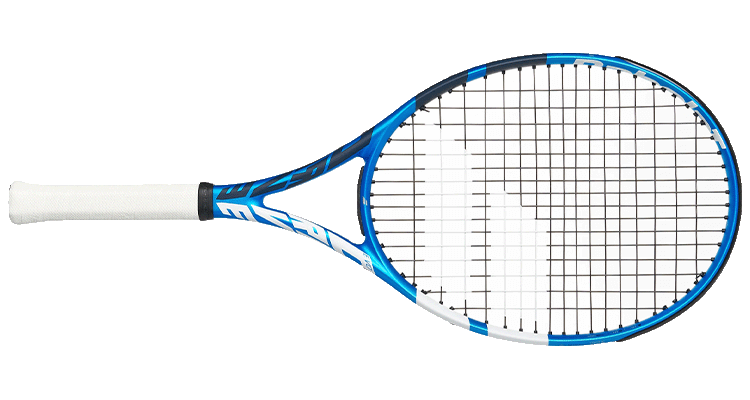
My pick for the best Babolat tennis racquet for beginners is the Babolat EVO Drive, which checks all the boxes that make for an excellent entry-level frame.
It has a larger 98 in² (671 cm²) head size, providing new players with an easy target and plenty of margin for error, a lighter 10oz (283g) weight, and a wide open 16×17 string pattern. The combination of attributes gives this racquet plenty of power and makes it easy to maneuver while delivering plenty of topspin.
Intermediate

Players who are steadily improving their skills, developing consistency, and building a strong feel for the game will find the Babolat Pure Strike to be a well-rounded option that delivers above-average performance across the board.
Overall, the Pure Strike provides intermediate players with an excellent platform to continue growing their skillset, and for many will be a racquet they can continue to use for years.
Strong Intermediate to Advanced
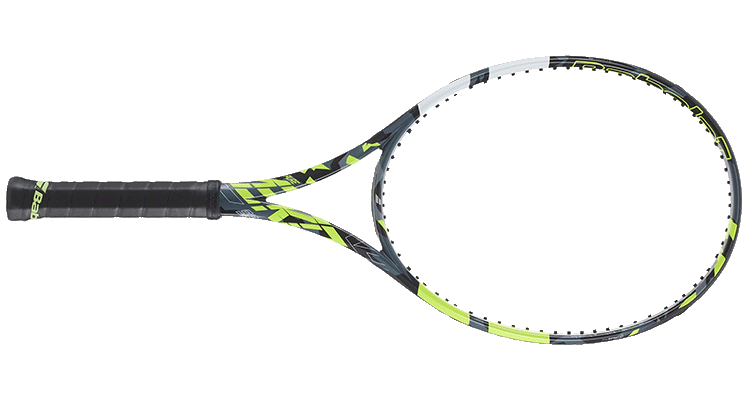
The Babolat Pure Aero 98 takes everything I love about the standard Pure Aero and makes a few minor adjustments that are well-suited for higher levels of the game.
Modifications include a smaller head size, extra weight, a thinner beam, and a tighter string pattern to deliver added control and stability that advanced players will appreciate.
Pros Using Babolat
One of the drivers of popularity for Babolat’s racquets includes an impressive roster of some of the biggest names in the sport, which heavily influences usage and adoption.
Of course, it all starts with an excellent product, which young players often adopt early and continue playing with as they transition to the ATP and WTA tours. From established pros like Rafael Nadal and Karolina Pliskova to newcomers like Carlos Alcaraz and Leyla Fernandez, Babolat has a strong list of players who use and endorse their racquets.
The following table lists the most prominent pros using Babolat racquets and the models they endorse.
| Men (ATP) | Racquet | Women (WTA) | Racquet |
| Adrian Mannarino | Babolat Pure Aero | Anet Kontaveit | Babolat Pure Strike 100 |
| Albert Ramos-Vinolas | Babolat Pure Drive Plus | Garbine Muguruza | Babolat Pure Drive |
| Benoit Paire | Babolat Pure Drive | Karolina Pliskova | Babolat Pure Drive |
| Botic van de Zandschulp | Babolat Pure Aero | Leylah Fernandez | Babolat Pure Aero |
| Cameron Norrie | Babolat Pure Strike | Sofia Kenin | Babolat Pure Drive |
| Carlos Alcaraz | Babolat Pure Aero VS | Danielle Collins | Babolat Pure Aero |
| Chun-Hsin Tseng | Babolat Pure Aero | Irina-Camelia Begu | Babolat Pure Drive |
| Dominc Thiem | Babolat Pure Strike | Yulia Putintseva | Babolat Pure Drive |
| Fabio Fognini | Babolat Pure Drive | Bernarda Pera | Babolat Pure Aero |
| Felix Auger-Aliassime | Babolat Pure Aero | Lucia Bronzetti | Babolat Pure Aero |
| Holger Rune | Babolat Pure Aero 98 | Alize Cornet | Babolat Pure Strike |
| Hugo Dellien | Babolat Pure Aero | Xinyu Wang | Babolat Pure Drive |
| James Duckworth | Babolat Pure Drive | Camila Osorio | Babolat Pure Drive |
| Jason Kubler | Babolat Pure Aero | Clara Burel | Babolat Pure Drive |
| Maxime Cressy | Babolat Pure Aero | Viktoriya Tomova | Babolat Pure Drive |
| Oscar Otte | Babolat Pure Aero | – | – |
| Rafael Nadal | Babolat Pure Aero | – | – |
| Taro Daniel | Babolat Pure Drive | – | – |
Please keep in mind that it’s common for professional players to play with customized or older versions of the racquets that Babolat paints to look like the model they endorse.
Also, this list isn’t exhaustive, and players change racquets periodically, so I’ll do my best to keep the list updated.
Men’s vs. Women’s
If you’re shopping for a Babolat racquet, you may wonder whether there are specific racquets in their lineup designed exclusively for men or women, and it turns out the answer is no. All of their racquets are unisex and can work well for both groups.
Moreover, no characteristics or attributes make one line or specific racquet better for men and women, as Babolat designs each frame for performance independent of gender.
With that said, many female tennis players will opt for Babolat racquets that are lighter because that’s what’s ideal for their size and build, but that’s not always the case. Many female tennis players will use heavier weighted racquets, especially at higher levels of the sport, for the same reasons men will, so there isn’t one rule you can apply to a specific gender.
Ultimately, it boils down to finding the best racquet that meets your needs and demoing whenever possible to understand what works well for your game.
Quality Control
If you get into the weeds of racquet design and manufacturing, one of the concepts you’ll come across is quality control, which refers to how closely racquets match quoted specifications. For example, if Babolat claims a racquet is 11.4 oz (323 g), how close do they meet that when producing their racquets.
The truth is, no racquet manufacturer gets it perfect. The production of racquets is complex, so there will always be a bit of variation, and Babolat understands this notion. When you buy one of their racquets, which Babolat manufacture in China, they quote weight and balance with a range, such as +/- 7, to signify that there will be variation from one racquet to the next.
Most players’ frustration arises when they purchase more than one of the same racquets, and the weight is different, resulting in a different feel as they switch from one to the next. Ideally, they’re as close a match as possible.
Overall, Babolat does a solid job on this front, and they’re usually very close to their specs. Of course, they’re not perfect, but you’ll often see minor variations. In these cases, it’s easy for players to make adjustments at home with a balance board and a scale if it’s a priority.
If you’re not up for customizing your racquets but want to see the specs match, some retailers will help you. A quick search for ‘racquet matching retailers’ online or visiting your local tennis shop should point you in the right direction.
Demos
Research is one of the best places to start when shopping for a Babolat racquet. By exploring online, you can learn a lot about their racquets, including their specs, technologies, and design.
However, once you’ve narrowed down a few frames you think might be a good fit, there’s no substitute for testing the racquets you’re interested in buying before making a purchase.
Enter demo programs, allowing you to gain first-hand experience hitting with a racquet to learn how it feels, which can go a long way to making sure you find one you love.
Unfortunately, demo programs aren’t available in all countries, but in the United States, they’re fairly pervasive, with most of the top online retailers offering the ability to test out racquets.
Typically, you can request to demo one to three racquets for a small fee that covers shipping and test them out for a few days to see how they perform before shipping them back.
As a bonus, most retailers offering these programs will apply a portion of what you spent for the demos to the purchase of a new racquet as an incentive to buy through them.
Warranties
Like most prominent top brands, Babolat offers a one-year warranty against defects in material or workmanship for their tennis racquets.
As you might expect, you’ll need to be able to show proof of purchase from Babolat or an authorized retailer. Furthermore, it’s a limited warranty so it won’t cover everything.
For example, their warranty doesn’t apply to racquet abuse, faulty stringing, or normal wear and tear, and the racquets that you submit for a claim will go through an inspection process to ensure the racquet meets their criteria for a valid claim. Since policies can change, I’d encourage you to check out Babolat’s warranty details before purchasing so you know what to expect.
With that said, I’ve owned many Babolat racquets and have never had a major issue that would have been cause for a claim. Yes, the racquets will wear over time, but that’s normal. In the long haul, you should expect your racquets to require maintenance to keep them in good shape, such as replacing the bumper guard or grommet strips.
One area where players will often get frustrated with their racquets is the paint chipping or scraping, and Babolat is not immune to this type of wear that warranties don’t cover. However, in my experience, their paint jobs are quality with few issues.
Play Better Tennis
Improve your game alongside our community of tennis players
Why join?
Discussion Boards
Join the conversation with other members of the community.
5 Point Friday
Read our weekly recap of the 5 most interesting things we dig up in tennis.
